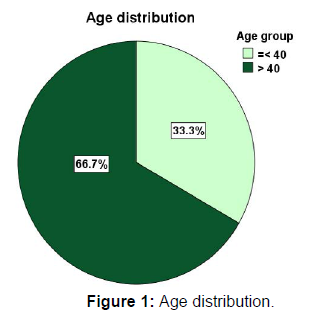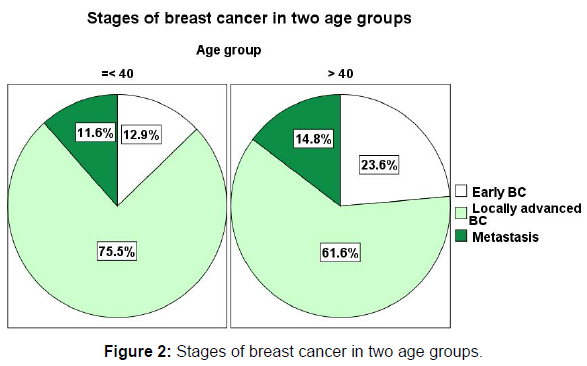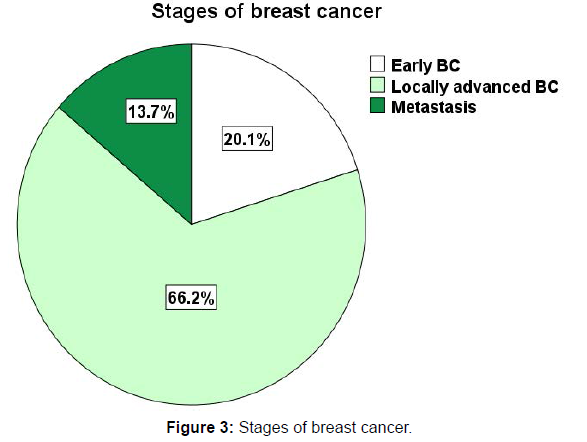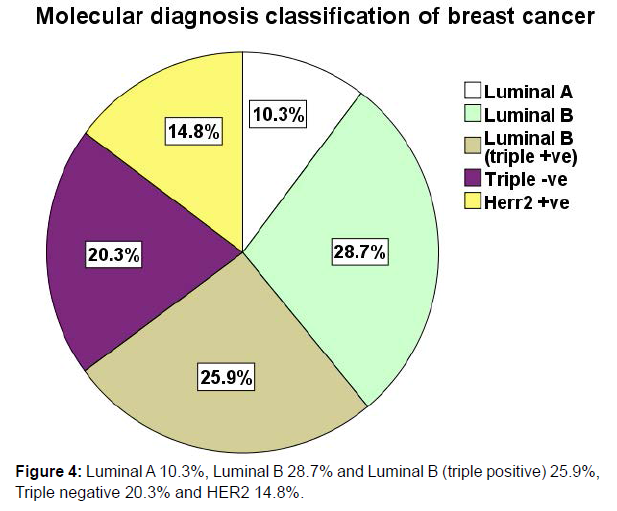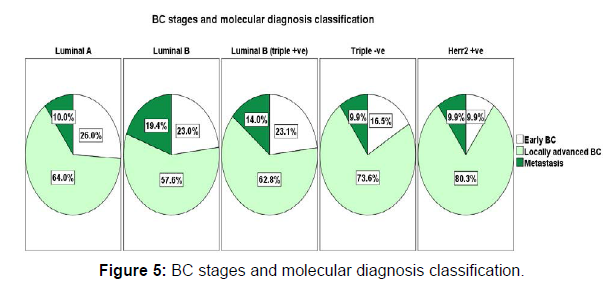Locally Advanced Breast Cancer Status: Experience at Sultan Qaboos University Hospital in the Sultanate of Oman
Received: 11-May-2022 / Manuscript No. bccr-22-63602 / Editor assigned: 13-May-2022 / PreQC No. bccr-22-63602 / Reviewed: 27-May-2022 / QC No. bccr-22-63602 / Revised: 01-Jun-2022 / Manuscript No. bccr-22-63602 / Accepted Date: 07-Jun-2022 / Published Date: 08-Jun-2022 DOI: 10.4172/2572-4118.1000160
Abstract
Background: Locally advanced breast cancer is a well-defined subcategory of Breast cancer associated with variable clinical outcomes. The lack of specificity in its presentation makes its treatment challenging resulting in a high risk of local recurrence. Local as well as regional studies on the incidence of LABC are quite scarce. We therefore designed a retrospective study to assess the incidence as well as age distribution of LABC.
Method: we conducted a retrospective analysis of patients presenting to our breast Unit to assess the prevalence of LABC and compared this with other subcategories of Breast Cancer. We also assessed the immunohistochemistry properties of breast cancer correlating it with age at presentation and risk of LABC. All patients were fully evaluated based on established protocols of breast cancer care.
Result: Our Study recruited 529 patients with breast cancer who had triple assessment conducted by consultants with breast cancer diagnosis confirmed. Our result showed that LABC was the overall commonest subcategory of breast cancer at 66.2%. It occurs more frequently in those under 40 accounting for 75.5% while 61.6% of patients over 40 had LABC p value=0.008. Luminal B was the commonest subtype seen in our center. Her2 positive and triple negative subtypes where more frequently associated with LABC at 80.3% and 76.3% respectively.
Conclusion: we concluded that LABC is the commonest pattern of Breast cancer noted in our center occurring frequently in patients under 40 years and is frequently associated with Her2 and triple negative subtype.
Keywords: Breast carcinoma, LABC, core biopsy, staging, MDT, molecular classification, Oman
Keywords
Breast carcinoma, LABC, core biopsy, staging, MDT, molecular classification, Oman
Introduction
The incidence of breast cancer is increasing in Oman and worldwide. With industrialization and urban development, delayed child birth and reduced fertility, westernization of lifestyle and increasing life expectancy among women, the incidence of breast cancer is increasing in all developing countries. Although breast cancer incidence rate has been increasing worldwide since 1950, mortality rates have leveled off or begun to decline in recent times. Countries that have a downturn in mortality are generally those with the highest rates while those with the lowest incidence rate tend to be the ones in which the mortality is increasing [1,2]. Breast cancer patients in Oman present in advanced stages and at younger ages than their counterparts in the West. The Mean age is 46.8 years and 48% of the female patients are premenopausal. As a result of this, the survival rates are lower. The overall 5-year survival rate in breast cancer patients in the western countries is 80%. On the other hand, it is only 50% in eastern countries [1]. The advanced stage of presentation of breast cancer in developing countries was attributed to the lack of mass education and screening programs, poverty, poor access to health care facilities, lack of expertise, and poor country infrastructure [1-7]. Omani women share a major burden of breast cancer incidence and associated mortality. The age-standardized incidence rate (ASIR) is 24.6 per 100,000 (cancer registry 2016). A recent study carried out in Oman found that the age at diagnosis is younger in Oman compared to their counterpart in the west and the majority of patients present at advanced stages of disease (III and IV) [1].
Locally advanced breast cancer is defined as a subcategory of breast cancer characterized by different presentations according to the National Comprehensive Cancer Network guideline. These include tumor more than 5cm in size with regional lymphadenopathy(N1-3), tumor of any size with direct extension to the chest wall or skin or both (including ulcer or satellite nodules) regardless of regional lymphadenopathy, or if it manifests as regional lymphadenopathy (fixed or matted axillary lymph node or infraclavicular, supraclavicular or internal mammary) irrespective of tumor stage [8]. In terms of outcome of breast cancer, it is known that the clinical behavior of breast cancer is variable. Many patients survive for extended periods of time with minimum treatment whereas others die relatively quickly despite the implementation of a combination of surgical, radiation and systemic therapy [9]. Most of the known factors which influence outcome relate to extent of the disease at the time of diagnosis [10]. Management of LABC is challenging among oncologists due to different manifestations of the disease. Multimodality of treatment consisting of surgery, chemotherapy, radiotherapy with or without hormonal and targeted therapy leads to better clinical outcomes [11].
Patients and Methods
This is a retrospective study of 529 consecutive cases presenting to Breast Clinic at Sultan Qaboos University Hospital (SQUH) between September 2010 and December 2015. All patients underwent triple assessment conducted by Consultants and Mammogram was done for patients above 35years or younger if the radiologist recommends it and there are no contraindications. However, Ultrasound was done for all patients with palpable lesion. Reports were assigned a score (BIRADS 0-6). Core biopsy and Fine Needle Aspiration Cytology (FNAC) were done for all patients with palpable abnormality or nipple discharge, US guided biopsy or stereotactic biopsy for non-palpable lesions or Micro calcifications respectively. Pathologists reported all core focusing on the side and site of the lesions, the histological types (ductal, lobular and other) grades, estrogen receptors status (ER), progesterone receptors status (PR) androgen receptors status (AR), Human Epidermal growth factor receptor 2 status (HER2 status) Ki67%, p53 mutations. Vimentin, E-cadherin and other immune status if needed.
The molecular classification was done according to the Immunohistochemistry status (ER, PR, HER2 and KI67%) for Luminal A (ER and PR positive, HER2 negative and KI67% less than 20%), for Luminal B (ER and PR positive, HER2 negative and KI67% more than 20%) and for Lumina B HER2 subtype or triple positive (ER, PR and HERS2 positive), HERS2 (HERS2 positive) and triple negative (ER and PR and HERS2 negative)
All patients had staging with CT scan chest/abdomen/ pelvis, Bone Scan or PET scan, cardiac echography and a series of blood tests. All cases were discussed in multidisciplinary Team meeting (MDT), staged and treatment plan taken by the board member and documented in the EPR track care system of the hospital
Statistical analysis
The SPSS version 20 software package was used for all data analysis.
Results
Among the 529 cases that were studied, 33.3% where ≤40 years whereas 66.7% where of the age group above 40 years (Figure 1). The mean age is 47.5(25-80) years. The Overall percentage diagnosis in various stages of breast cancer was 20.1% in early stage, 66.2% had locally advanced disease and 13.7% had distant metastases respectively (Figure 2). Among those in the age group below 40 age group, 12.9% were detected in the early stage, 75.5% in the locally advanced stage and 11.6% where in the metastatic stage of disease respectively compared to the age group above 40 years, in which 23.6% were in early stage, 61.6% had locally advanced disease and 14.8% distant metastases. The p value is statistically significant at 0.008 (Figure 3). According to the molecular classification of breast cancer in all 529 patients studied, luminal A accounted for 10.3%, luminal B 28.7%, luminal B Hers2 subtype (triple positive) were 25.9% while (triple negative) accounted for 20.3% and Hers2 positive subtype were 14.8% (Figure 4). If the molecular diagnosis classification were grouped according to the stage of the disease, the result was as follows: In early breast cancer, 13.7% were luminal A positive, 33.7% luminal B 29.5% luminal B Hers2 subtype (triple positive), 15.8% triple negative and 7.4% HER2 positive. In locally advanced breast cancer, 10.3% were luminal A, 25.6% luminal B, 24.2% luminal B HER2 subtype (triple positive) 21.5% triple negative and 18.3% HER2 positive respectively. In metastatic stages, 7.7% were luminal A, 41.5% luminal B, 26.2% luminal B (triple positive) 13.8% triple negative and 10.8% HER2 positive respectively, the P value was 0.035, which is statistically significant (Figure 5).
Discussion
Breast cancer is the commonest female cancer nationwide and worldwide [12]. The incidence and prevalence are more in western countries compared to eastern countries nevertheless, the incidence is increasing rapidly in the East, with industrialization and urban development, delayed child birth and reduced fertility, westernization of lifestyle and increasing life expectancy among women [13-15].
Different papers and studies from Asian, African and Western countries showed that there are epidemiologic and clinical outcome disparities of breast cancer between west and east, some differences cannot be ignored and left without further research and investigation. The mean age of incidence of breast cancer is between 45-50 years in the Asian and African, whereas its between 60-65 years in Western countries [13-16]. The age standardized incidence rate in Oman is 26.9, which is less compared to western countries (MOH cancer registry 2015), on the other hand, the majority of patients presents at a younger age and diagnosed with advanced disease [1]. The outcome of breast cancer is multifactorial, however tumor size, grading, lymph nodes status and IHC (ER, PR, HER2 and KI67%) all influence the outcome of therapy [17].
In this study, we have observed that the mean age of incidence of breast cancer in Omani females is 47.5 (25-80), which is almost 2-decade younger compared to their counterpart in the west [12-15]. The percentage of patients who were diagnosed with breast cancer at younger age (<40 years) was 33.3%. The percentage of locally advanced breast cancer (LABC) was 66.2%. Overall, we found that the LABC is commoner in younger age group <40 years old compared to the age group >40 years old at 75.5% and 61.6% respectively (Figure 3) which is statistically significant 0.008. If these figures are compared with SEER17 database when they are diagnosed at an older age (> 60years), it stood at 71.3% and localized stage was 61.2%. Tumors were classified into molecular subtypes based on IHC markers status findings Thus four subtypes were defined: Luminal A, Luminal B (including luminal B like ER PR and HER2 positive, HERS2 and triple negative) [18-20].
Worldwide the molecular classification of breast cancer results are very controversial, and differ from one institute to other according to the endocrine intensity (ER and PR status) and the proliferation percentage (Ki 675%) [21-23]. In this study the results showed the luminal A accounts for 10.3% of all subtypes and was found to be higher in some international studies and lower in others [22-26]. Luminal B stood at 28.7% which is the most common even if left alone without the luminal B like (ER, PR and Hers2 positive) Although this figure is higher than studies in India, it is similar to studies from Morocco [25-27] but if Luminal B and the luminal B like (ER, PR and HER2 positive) are merged together, then the luminal B would account for 54.6%, which is close to the Egyptian study [28].
The triple negative values stood at 20.3% showing pattern similar to other countries, except to India and Indonesia where they have TNBC higher than our study 26% and 25.5% respectively [23,25] and the Her2 was 14.8%, which is again comparative to international figures [21- 29]. We have noticed that the molecular classification of Her2 and the triple negative were the highest in LABC 80.3% and 73.6% respectively compared to Luminal A and B which was statistically significant P value is 0.035 [25].
In Oman, the medical health service is readily and freely available to all citizens, and has one of the best health services according to the WHO classification. In spite of this, we still see majority of newly diagnosed breast cancer as LABC. The reason could be multifactorial, could be due to lack of awareness among people, lack of proper screening programs or could be due to cultural habits. On the other had we have a more aggressive biological breast cancer compared to western countries and the onset of the disease at younger age of groups.
Conclusion
LABC is the commonest subcategory of breast cancer seen in our center. Effort at improving early detection of breast cancer can be achieved by creating an awareness campaigns through the distribution of booklets about information related to breast disease. The awareness needs to be created among all females fertile age group regarding self-examination for any changes in the breast keeping in mind that prevention is always better than cure and not to mention that the screening program must be suitable to our needs.
Ethics Approval and consent to participate
The study was approved by the Hospitals Ethical Committee.
Competing Interests
The authors declare that they have no competing interest.
Funding
This was a retrospective study requiring no funding.
References
- Kumar S, Burney IA, Al-Ajmi A, Al-Moundhri MS (2011) Changing Trends of Breast Cancer Survival in Sultanate of Oman. J Oncol 2011: 316243.
- Al-Moundhri M, Al-Bahrani B, Pervez I, Ganguly SS, Nirmala V, et al. (2004) The Outcome of Treatment of Breast Cancer in A Developing Country-Oman. Breast 13: 139-145.
- Aziz Z, Iqbal J, Akram M (2008) Predictive and Prognostic Factors Associated with Survival Outcomes in Patients with Stage I-III Breast Cancer: A Report from A Developing Country. Asia-Pac J Clin Oncol 4: 81-90.
- Badar F, Faruqui ZS, Ashraf A, Uddin N (2007) Third World Issues in Breast Cancer Detection. J Pak Med Assoc 57: 137-140.
- Raina V, Bhutani M, Bedi R, Sharma A, Deo SV, et al. (2005) Clinical Features and Prognostic Factors of Early Breast Cancer at A Major Cancer Center in North India. Indian J Cancer 42: 40-45.
- Aziz Z, Sana S, Akram M, Saeed A (2004) Socioeconomic Status and Breast Cancer Survival in Pakistani Women. J Pak Med Assoc 54: 448-453.
- Agarwal G, Ramakant P, Sánchez Forgach ER, Rendón JC, Chaparro JM, et al. (2009) Breast Cancer Care in Developing Countries. World J Surg 33: 2069-2076.
- Gradishar WJ, Anderson BO, Balassanian R, Blair SL, Burstein H, et al. (2015) National Comprehensive Cancer Network (NCCN) Clinical Practice Guidelines in Oncology: Breast Cancer. JNCCN 13: 448-475.
- Bloom HJG, Richardson WW, Harries EJ (1962) Natural History of Untreated Breast Cancer (1805-1933) Comparison of Untreated and Treated Cases According to Histological Grade of Malignancy. Br Med J 2: 213-221.
- Thomson CS, Hole DJ, Twelves CJ, Brewster DH, Black RJ, et al. (2001) Prognostic Factors in Women with Breast Cancer: Distribution by Socioeconomic Status and Effect on Differences in Survival. J Epidemiol Community Health 55: 308-315.
- Lee MC, Newman LA (2007) Management of patients with locally advanced breast cancer. Surg Clin North Am 87: 379-398.
- Bray F, Ferlay J, Soerjomataram I, Siegel RL, Torre LA , et al. (2018) Global Cancer Statistics (2018): GLOBOCAN Estimates of Incidence and Mortality Worldwide for 36 Cancers in 185 Countries. CA Cancer J Clin 68: 394-424.
- Fan L, Zheng Y, Yu KD, Liu GY, Wu J, et al. (2009) Breast Cancer in A Transitional Society Over 18 Years: Trends and Present Status in Shanghai China. Breast Cancer Res Treat 117: 409-416.
- Son BH, Kwak BS, Kim JK, Kim HJ, Hong SJ, et al. (2006) Changing Patterns in the Clinical Characteristics of Korean Patients with Breast Cancer During the Last 15 Years. Arch Surg 141: 155-160
- Aphinives P, Punchai S, Vajirodom D, Bhudhisawasdi V (2010) Breast Cancer: Five-Year Survival in Srinagarind Hospital, Thailand. J Med Assoc Thai 93: S25-S29.
- Elkum N, Dermime S, Ajarim D, Al-Zahrani A, Alsayed A, et al. (2007) Being 40 or Younger is an Independent Risk Factor For Relapse in Operable Breast Cancer Patients: The Saudi Arabia Experience. BMC Cancer 7: 222.
- Viale G (2012) The Current State of Breast Cancer Classification. Ann Oncol 23: x207-x210.
- Coates AS, Winer EP, Goldhirsch A, Gelber RD, Gnant M, et al. (2015) Tailoring Therapies—Improving the Management of Early Breast Cancer: St Gallen International Expert Consensus on the Primary Therapy of Early Breast Cancer 2015. Ann Oncol 26: 1533-1546.
- Goldhirsch A, Winer EP, Coates A, Gelber R, Piccart-Gebhart M, et al. (2013) Personalizing the Treatment of Women with Early Breast Cancer: Highlights of the St Gallen International Expert Consensus on the Primary Therapy of Early Breast Cancer 2013. Ann Oncol 24: 2206-2223.
- Prat A, Cheang MCU, Martín M, Parker JS, Carrasco E, et al. (2012) Prognostic Significance of Progesterone Receptor–Positive Tumor Cells within Immunohistochemically Defined Luminal A Breast Cancer. J Clin Oncol 31: 203-209.
- Bouchalova K, Cizkova M, Cwiertka K, Trojanec R, Hajduch M (2009) Triple Negative Breast Cancer –Current Status and Prospective Targeted Treatment Based on HER1(EGFR), TOP2A and C-MYC Gene Assessment. Biomed Pap Med Fac Univ Palacky Olomouc Czech Republic 153: 13-17.
- Al-Thoubaity FK (2020) Molecular Classification of Breast Cancer: A Retrospective Cohort Study. Ann Med Surg (Lond) 49: 44-48.
- Al Tamimi DM, Shawarby MA, Ahmed A, Hassan AK, AlOdaini AA (2010) Protein Expression Profile and Prevalence Pattern of the Molecular Classes of Breast Cancer - A Saudi Population Based Study. BMC Cancer 10: 223.
- Setyawati Y, Rahmawati Y, Widodo I, Ghozali A, Purnomosari D (2018) The Association Between Molecular Subtypes of Breast Cancer with Histological Grade and Lymph Node Metastases in Indonesian Woman. Asian Pac J Cancer Prev 19: 1263-1268.
- Errahhali ME, Errahhali ME, Ouarzane M, El Harroudi T, Afqir S, et al. (2017) First Report on Molecular Breast Cancer Subtypes and Their Clinico-Pathological Characteristics in Eastern Morocco: Series of 2260 Cases. BMC Womens Health 17: 3.
- Pandit P, Patil R, Palwe V, Gandhe S, Patil R, et al. (2020) Prevalence of Molecular Subtypes of Breast Cancer: A Single Institutional Experience of 2062 Patients. Eur J Breast Health16: 39-43.
- Fragomeni SM, Sciallis A, Jeruss JS (2018) Molecular Subtypes and Local-Regional Control of Breast Cancer. Surg Oncol Clin N Am 27: 95-120.
- Elesawy BH, El hafez AA, Shawky AEA, Arafa M (2014) Immunohistochemistry- Based Subtyping of Breast Carcinoma in Egyptian Women: A Clinicopathologic Study on 125 Patients. Ann Diagn Pathol 18: 21-26.
- Eliyatkin NO, Aktas S, Zengel B, Postaci H, Uslu A, et al. (2016) Molecular Subtyping of Breast Cancer Patients with Long Time Follow Up and its Prognostic Value on Survival: A Single Center Analysis. Int J Clin Exp Med 9: 11526-11533. Google Scholar
Indexed at, Google Scholar, Crossref
Indexed at, Google Scholar, Crossref
Indexed at, Google Scholar, Crossref
Indexed at, Google Scholar, Crossref
Indexed at, Google Scholar, Crossref
Indexed at, Google Scholar, Crossref
Indexed at, Google Scholar, Crossref
Indexed at, Google Scholar, Crossref
Indexed at, Google Scholar, Crossref
Indexed at, Google Scholar, Crossref
Indexed at, Google Scholar, Crossref
Indexed at, Google Scholar, Crossref
Indexed at, Google Scholar, Crossref
Indexed at, Google Scholar, Crossref
Indexed at, Google Scholar, Crossref
Indexed at, Google Scholar, Crossref
Indexed at, Google Scholar, Crossref
Indexed at, Google Scholar, Crossref
Indexed at, Google Scholar, Crossref
Indexed at, Google Scholar, Crossref
Indexed at, Google Scholar, Crossref
Indexed at, Google Scholar, Crossref
Indexed at, Google Scholar, Crossref
Citation: Aljarrah A, Aboje AE, AlMabsali H, Alazri M, Ameri UA, et al. (2022) Locally Advanced Breast Cancer Status: Experience at Sultan Qaboos University Hospital in the Sultanate of Oman. Breast Can Curr Res 7: 160. DOI: 10.4172/2572-4118.1000160
Copyright: © 2022 Brown T. This is an open-access article distributed under the terms of the Creative Commons Attribution License, which permits unrestricted use, distribution, and reproduction in any medium, provided the original author and source are credited.
Select your language of interest to view the total content in your interested language
Share This Article
Recommended Journals
Open Access Journals
Article Tools
Article Usage
- Total views: 3888
- [From(publication date): 0-2022 - Nov 20, 2025]
- Breakdown by view type
- HTML page views: 3375
- PDF downloads: 513

